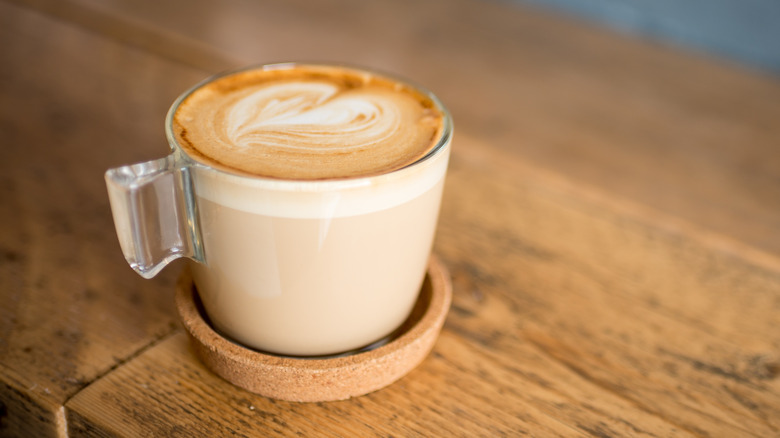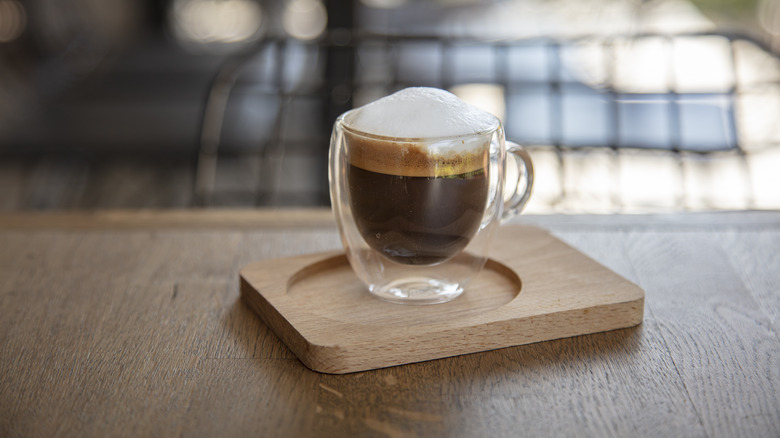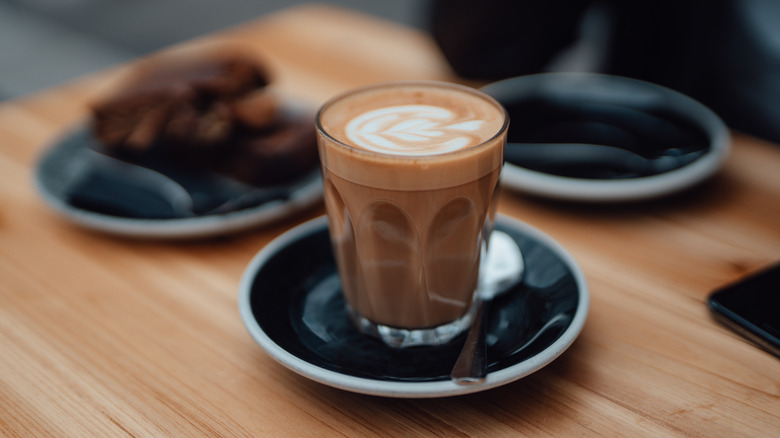Macchiato Vs Flat White: What's The Flavor And Caffeine Difference?
It's easy to see why a macchiato and a flat white might be confused with one another. After all, they are both hot, caffeinated coffee drinks that are made from just two ingredients: espresso and milk. But there are subtle differences between the beverages that change their flavor. Whereas a macchiato has a strong and punchy taste, flat whites are more milky and mild, and this all has to do with the ratio of the two ingredients.
The word macchiato was coined in the 1980s by Italian baristas. Hoping to help servers distinguish between orders of plain espresso and those that were spiked with a splash of milk, they came up with the name macchiato — Italian for "marked" or "stained." This is exactly what the drink is: A shot of espresso "stained" with a tiny layer of frothed milk.
The flat white originated in the same decade in the Australasia region, but its exact place of birth is a topic of passionate debate. Much like pavlova, which has caused a feud between Australia and New Zealand, these two countries both lay claim to the flat white. What we do know for sure is that a flat white is made from a shot of espresso, like a macchiato, except it uses more milk (resulting in a larger serving, generally speaking). Though the exact ratios differ from recipe to recipe, it typically uses an equal amount or up to twice the quantity of steamed milk as espresso.
The flavor and texture of a macchiato and a flat white
Because a macchiato is essentially just a shot or two of espresso with a dot of milk, it is a very robust-tasting drink. It highlights the notes of the coffee beans more, with just a hint of sweetness from the dairy to cut through the intensity of the espresso. In comparison, the higher proportion of milk in a flat white gives it a softer, smoother, and more balanced flavor.
Another key difference is the way in which the milk is prepared. The milk used to make a macchiato is frothed. This turns the liquid into a thick, dense, and airy foam that holds its shape well. The foam floats on top of the espresso in a distinct layer without blending into it, creating two striking parts of milk and espresso in the drink. As a result, a macchiato is essentially like drinking an espresso, but with a tiny mouthful of foam in each sip.
On the flip side, flat whites use milk that is steamed until very tiny bubbles form, creating what is called "microfoam." This foam is so fine and delicate that it gives the milk a velvety texture which smoothly blends into the espresso. The result is an incredibly silky beverage that is more rich and creamy than a macchiato.
Determining the caffeine content of the two coffees
You might think that the differing ratios of milk play a role in the caffeine content of a macchiato and a flat white, but that's not the case — it's one of many longstanding myths about coffee. While milk certainly influences the flavor of a java, it does not alter caffeine's chemical structure or reduce its strength. Instead, the caffeine content in these drinks comes down to the number of espresso shots used.
Regardless of the serving size and the proportion of milk, both macchiatos and flat whites contain roughly 63 mg of caffeine, if they are made with one espresso shot. If made with two shots, the caffeine will obviously double. That said, the exact caffeine content in your cup can vary. The type of beans used to brew the espresso shot matters; for instance, the popular robusta and arabica beans deliver different amounts of caffeine. The quantity of beans can play a role, too, as can the specific brand you use. All-in-all, macchiatos and flat whites only have as much caffeine as the espresso shots used to make them.
What milk does change, however, is the nutritional value of both drinks. Since a macchiato has less milk, it will also have less calories, fat, and protein. For example, a macchiato contains five to 18 calories depending on its size, whereas a flat white can have between 48 to 110 — but expect to get a similar buzz from both.



